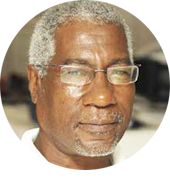
Twenty-twenty three (2023) was not exactly a wet year for water.
Instead, last year was the hottest year on record, a reflection of the acute changes haunting humankind in the 21st Century, accelerating faster everywhere than ever before.
Water is, indeed, in grave danger and the signs have been ever-present: El Nino and La Nina, melting glaciers, rising sea levels, hotter oceans, accelerated carbon depletion, increasing loss and damage to small island and developing nations, worsening forest fires, deadly heat waves and floods, coral bleaching, deepening frost, parching drought, oceans drowning islands and rivers running dry.
But, just as ever, the red flags have all been largely left unattended — until they boiled-over into different servings of the accelerating global climate and environmental crises.
Europe and the USA ignored paying early attention to effects of drought levels in main rivers, until they started drying-up and threatening river cargo and entire cities’ water reserves.
Also, in too many cases, kneejerk easy-way-out reactions have resulted in spill-off decisions worsening other global crises — from decreasing water production and services to increasing cots and prices and not sufficiently addressing the core issues affecting water conservation, production and distribution.
The world accepts that ‘Water is Life!’, an infinitely precious resource for everyone everywhere on Planet Earth.
Water, War and Peace
Water is more precious to life than precious metals, oil or liquid natural gas — so-much-so, that creative imaginations have led to a scenario of an eventual apocalyptic World Water War, as realistically fictionalized in the 20th Century hit movie ‘Mad Max – Beyond the Thunderdome’ (starring Mel Gibson and Tina Turner).
But while the thought of 22nd or 23rd Century global pockets of tribal wars over water may still be just the stuff movies are made of, the end of the First Quarter of the Second Millennium is already a time when more people in poor nations are dying from thirst, with water being used as a Weapon of War.
For example, water is one of the major factors behind the repeated conflicts in Kashmir between India and Pakistan; and Egypt, Ethiopia and other nations along the River Nile constantly threaten to go to war over access to its water – or the sea.
Worse, wherever wars and armed conflicts or disasters lead to mass evacuation, displacement and migration – whether in Sudan, Gaza or Haiti today – water becomes the one resource that keeps the thirsty and hungry alive.
Different treatment
How water is treated by governments and utilities differs in Africa, the Americas, Asia, the Caribbean, or Europe.
As a result, in 2024, 2.2 billion people worldwide still don’t have access to safe drinking water and about half the global population (4 billion) is without safe sanitation.
In 90% of developing countries, untreated waste water is poured directly into the environment — mainly the sea – resulting in 1,000 children dying every day from illnesses caused by drinking contaminated or dirty water.
As seen in Sudan, Ukraine and Gaza, water infrastructure is targeted in conflicts and millions move to neighbouring states, further depleting available low-level water stocks.
Water is also at such a stage in 2024 where the United Nations (UN) annual water reports are again repeating the usual case for the absolute necessity of making safe water available to everyone, everywhere.
UN Secretary General Antonio Guterres says water has a role in making peace worldwide.
The UN designated the theme for World Water Day 2024 (22 March) as ‘Water for Peace’ and the UN World Water Development Report 2024 is also titled ‘Water for Prosperity and Peace’.
But nations sharing water tend to fight over how and how-much to share and who owns access where.
For example, at least 153 member-states of the UN share water resources, yet only 24 have related cooperation agreements.
In his message this year, the UN Secretary General emphasized the urgent need for increased transboundary water cooperation, but stressing that “Achieving it relies on far-greater cooperation.”
Guterres called for “accelerated efforts” to “work together across borders” and urged joint global action to implement the UN Water Convention, which promotes managing shared water resources sustainably.
Less Water
But while nations continue to differ over water, the resource is getting more-scarce everywhere each year, affecting other equally important world resources like food and agriculture.
Reports indicate that to keep pace with the global demand for food, crop production must grow by at least 50% by 2050.
A 2017 paper estimated that to match crop production to expected demand, water use for irrigation would have to increase by 146% by the middle of this 21st Century.
World water availability is declining greatly today, as more continental rivers run dry from reduced rainfall, resulting in declining river flows and rising temperatures, causing increased evaporation and increased transpiration by plants.
Agriculture swallows over 90% of the world’s freshwater, but what’s needed to meet growing food demand is simply unavailable.
Such reports are frequent and ought to have sent alarms, but are just-as-frequently ignored by policymakers everywhere.
All not lost…
Yet, not all is lost, as regions and nations most and worst affected – particularly in the global South – are usually forced by circumstances to act quickly.
In the Caribbean, governments and water utilities have been working closer to share common experiences and resources to better manage mutual challenges, from managing wastewater to reducing levels of non-revenue water – and everything else flowing between.
CAWASA, the Saint Lucia-based regional association uniting utilities, has been working with European and Caribbean friends and associated agencies to harness efforts at uniting the region’s approach to common challenges with common solutions.
Its Executive Director, Ignatius Jean, told a regional World Water Day activity here last week that the future of Caribbean water lies in continuing cooperation between utilities and other stakeholders, failing which the regional water sector could die from thirst for help.





